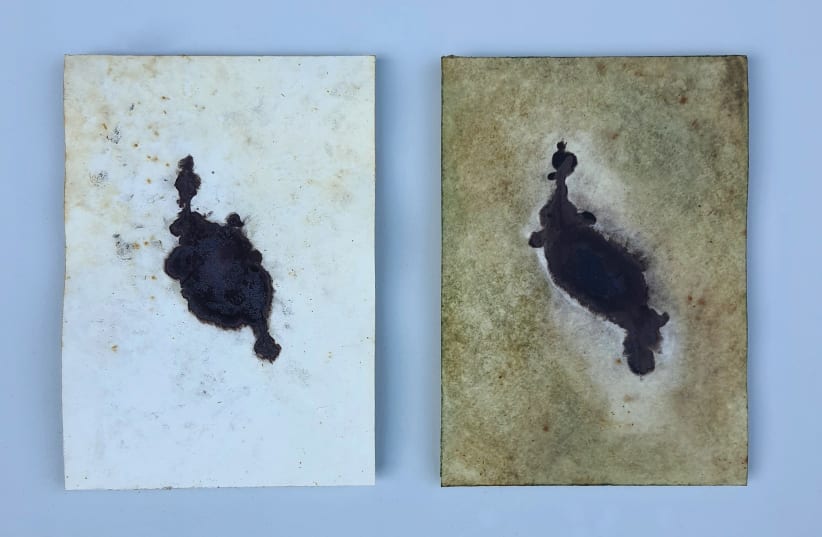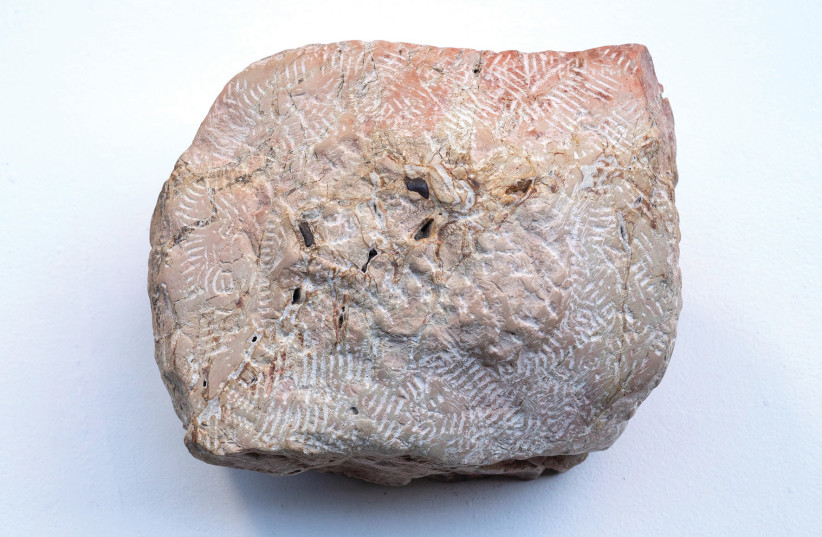A stone’s throw from Jerusalem Boulevard, the Askilla space functions as a make-shift shtiebel, a library with charmingly outdated books on Jewish culture, such as Jacob Isaacs’s Our People or The Synagogue, by Brian de Breffny, with various portraits of the Lubavitcher Rebbe hung about the space to offer warmth.
It is a blend of an urban space meant to introduce secular people to their Jewish roots, a space for study and discussion, and, so it seems, art.
It’s where self-taught sculptor Yoav Ben Dov will open a new exhibition on Thursday at Askilla, Jaffa.
“I do not accept the term ‘secular’,” the owner, Etay Gabay, informs me as he makes coffee. “The word hiloni means ‘stranger’, and no Jew is a stranger.”
Gabay became Torah observant, a baal teshuva, roughly two decades ago and while Askilla had been operating for the past three years, it redefined itself as a space for the arts recently.
In that it is taking part in a larger trend across the country, as artists who are practicing Jews and artists who engage with Jewish concepts and themes form a new trend.
Just as restaurants increasingly become kosher to stay in business by catering to more patrons, there seems to be a crackling of energy in the visual arts, too. Israeli artists had almost always dealt with their own Jewishness and Jewish values, yet, as the body politic becomes rigidly right-leaning, there is now a growing feeling of a comeuppance of sorts.
If, in 2001 David Reeb painted Arik Eats Children, alluding to Arik Sharon, and Ariel Bronz stuck a flag up his rear in a 2016 performance of Love the Juice, now things are different. A scandal over Reeb’s painting, Jerusalem of Shit, led to the Ramat Gan Museum of Israeli Art not being able to function. What other works will present themselves to this new audience in these different times?
Ben Dov was busy mounting three large stone works on the wall, ahead of the exhibition’s opening. From right to left they were Jerusalem Stone, a gentle fossil-like work with intricate carvings, Desert (Midbar) Stone, and Sand Stone. On the last work, a human hand was created using iron and rust, lending it a timeless quality seeing that the imprint of one’s hand is one of the oldest artworks humans engage in.
Lined up, the works are called Avnai Makom, which could mean “Place Stones” but also allude to the stones used by Jacob as a pillow when he dreamt of a ladder going up to heaven with angels descending it. It is also possible to read the works as a journey from Jerusalem, the city, to the Judean desert and then to the sands of the Tel Aviv beach. Making the Makom, or “Place,” the land of Israel.
They are impressive, verge on the abstract and allow Ben Dov to have a lot of fun with words.
For example, he enjoyed pointing out that the Hebrew word for desert, “Midbar”, is very close to speaking, “Medaber”. Showing an almost Duchamp-like sense of play, Ben Dov informed The Jerusalem Post that the work Jerusalem Stone is “my Jerusalem. I can sell Jerusalem because I am an artist.” He says with a serious face, “most people cannot do such things.”
IN ANOTHER work, which is called Keren Zavit (Corner Angle) he carefully carved a block of stone to create an optical illusion. When you see it at a distance, it seems like a four-cornered block of stone, as you step near it, you see that there is no corner at all. It was in your mind the entire time.
“This is why there is the expression,” Gabay said, ‘the crown of Torah is laying at Keren Zavit, how will you grab it?’” While the expression can be understood at face value, the Torah is laying at the corner of the house and anyone who wishes to study it is able to do so – it can also be understood as a great gag.
The cornerstone of the house, after all, is used to determine how the walls are built. So it is inside the walls of the house. There is a stone that shaped the structure where one spends an entire lifetime but it is hidden from the eye. How, then, can you grab it? In the case of Keren Zavit, there is no angle at all: it was created at the meeting point between the viewer and the seen object.
Self-taught, Ben Dov worked as a teenage apprentice to painter Avraham Bazak and sculptor Tovya Yoster at Ein Hod. As an adult, he worked with Uri Lifschitz, a provocative painter who was shunned for a long time by the Israeli art circle for his shocking views. “Lifschitz”, art critic Gideon Ofrat wrote of him, “did not like very much the author of this book” or anyone else who wrote about art, whom Lifschitz regarded as parasites.
“I was a good apprentice”, Ben Dov told the Post, “I knew what Uri was thinking: if he wanted blue paint I already had three different types to offer him when he turned around.” He then roared with laughter, “readers will say: ‘How hard does a painter work that he must have another man open jars of paint for him?’” he elbowed Gabay.
With white hair and a kind expression, Ben Dov rolled his own smokes and discussed how he resents art that attempts to shove an ideology down the viewer’s throat. When asked about the Sistine Chapel, a marvel painted for the glory of the Catholic Church, he asked: ‘Who remembers who commissioned it? People only know who painted it.’” That was Michelangelo. The pope who signed on the works was Sixtus, hence the name of the chapel. Sixtus also signed off on the Inquisition, in 1478.
“Renaissance art was nonsense,” Ben Dov told the Post, “its entire focus was to re-do something which was already done. Leonardo De Vinci was a Middle Ages kind of guy, he invented new things.”
“It was the Renaissance,” he added, “which enabled the rise of Secularism.”
Jerusalem Syndrome by Yoav Ben Dov will open from Thursday, December 22, at 8 p.m. to Sunday, January 22. On Monday, January 5, at noon, a Hebrew encounter with the artist will take place.
Admission is free to all events. Askilla is located at 2 Shimon Ben Shetach St. Jaffa. Opening Hours are Tuesday from noon to 2 p.m., Wednesday from noon to 4 p.m. and from 8 p.m. to 10 p.m., Thursday from 8 p.m. to 10 p.m., and Friday from 10 a.m. to 4 p.m.

